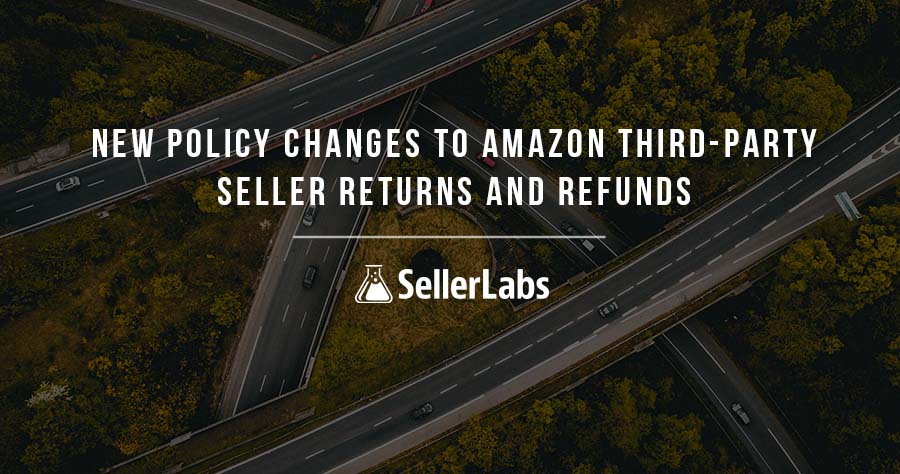By now, if you’ve not directly received an email from Amazon about its new policy changes to third-party seller returns and refunds regarding, you’ve likely read about it on the Seller Forums (Thread: New Amazon Return System and Thread: NEW 2017 RETURN POLICY – What Protection Do Sellers Have to Manage PROBLEMS) or in a news article.
Or maybe you’re like some sellers who claim not to have received the message or haven’t seen the update in the Seller Central’s Headlines section. The news is big and we’ve received questions and comments on social media from sellers seeking more information or clarification so we thought now would be a good time to address the changes to the returns policy in hopes that no seller is left in the dark.
BASICS ABOUT THE NEW AMAZON RETURNS/REFUNDS POLICY
- There are two major changes regarding returns and refunds: Automatic Authorization (also referred to as Pre-Authorized Returns) and Returnless Refunds.
- The changes affect sellers who ship products themselves rather than using Amazon’s warehouses and the Fulfillment By Amazon program.
- Changes take effect on October 2, 2017, and sellers are required to have a return address on file by this date (failure to do so means that the business address you’ve provided will be used as the return address).
THE CHANGES IN A NUTSHELL
- Sellers must now accept returns in the same manner that Amazon does in handling its own inventory and FBA items; namely, customers utilize a prepaid return shipping label via the Online Return Center and send the package back via the designated carrier.
- Given the above, there will no longer be any interaction between the buyer and the seller regarding returns. Everything will be handled and tracked within the Manage Returns page in Seller Central.
- Sellers are required to issue a refund within two business days of receipt of a return. Should you fail to do so, “Amazon may refund the customer on your behalf and charge the amount to your seller account.”
- Sellers will be able to set rules and automatically issue a refund without requiring the buyer to actually send the item back in what is known as a Returnless Refund. This offering is completely optional.
- You will be responsible for the cost of return shipping in accordance with Amazon’s policies (rates are viewable on Seller Central but deemed confidential, hence the lack of link).
- You can request exemptions for specific items in your inventory after August 31.
- You can appeal return disputes directly with Amazon.
RETURN AND RESTOCKING FEE POLICY
- You can file an appeal if Amazon authorized a return or refund on your behalf that you don’t believe should have been authorized, or the item came back to you in unacceptable condition, or the customer selected an incorrect return reason code. You can appeal the order as soon as the customer ships the item back to you. Until the item is shipped, your account will not be charged, and therefore you cannot file an appeal. Note: Normal wear-and-tear can be accounted for by charging a restocking fee in accordance with the restocking fee policy.
- For customer-fault returns (e.g. accidental order, better price available), you may deduct the cost of return shipping from the refund. Further restocking fees are also allowed. More here.
ACCORDING TO AMAZON’S EMAIL TO SELLERS
- Pre-Authorized Returns are for the purpose of providing consistency within the customer experience and the changes ought to be considered “simplifying the returns process on items fulfilled by sellers.”
- A Returnless Refund is the result of sellers asking for the option “because, in many cases, it allows you to save on both return shipping and processing costs,” particularly in the case of low-priced items where shipping costs more than the product.
- The company hopes that “these changes will reduce the effort required to manage your returns and decrease your customer Return Dissatisfaction Rate (RDR), thereby improving your ratings.” Bonus stat courtesy of Amazon: Early participants have seen RDR go down by an average of three times after offering prepaid return shipping.
- If you want to embrace the changes before October 2, you can contact Amazon by August 11 in order to onboard by August 25. Given the mostly negative reactions from sellers (to put it mildly), I don’t anticipate this option getting a lot of interest, but the choice is yours and I want to present it to you.
THE CHALLENGE OF BREAKING DOWN THE NEW RETURNS AND REFUNDS POLICY
Our editorial team tries to present thoughtful, balanced analysis of industry news rather than knee-jerk hot takes, but this change to Amazon policy is a tough one when it comes to reserving judgment and digging deeper into possible implications and ramifications.
In short, there’s not a lot here to speak of positively, especially when media coverage includes stories like CNBC’s Amazon’s New Refunds Policy Will ‘Crush’ Small Businesses, Outraged Sellers Say and Consumerist’s Amazon Changes Return Policies For Third-Party Sellers, Who Worry About Fraud and eSellerCafe’s Amazon Forcing Pre-Authorized Returns on Marketplace Sellers. Oof, to say the least.
TAKE A DEEP BREATH AND TAKE THE CHANGES WITH A GRAIN OF SALT
At best, this is Amazon enacting procedures to ensure that buyers receive the same levels of service across the board, whether they buy from Amazon or a third-party seller. That’s fair given that buyers don’t always understand the difference in how their orders are fulfilled, it doesn’t always matter to them from where a product comes, and they should expect consistency that protects them from shoddy products, fakes, and damaged items. In theory, 3P sellers have always been held to Amazon’s high standards of customer service and they are already expected to “have return policies that are at least as favorable as the Amazon return policies.” So in that sense, little changes from the existing returns policy as customers see it.
HOWEVER, THE CHANGES DON’T SIT RIGHT WITH MOST SELLERS. HERE’S WHY:
For all that hasn’t changed and for the updates that might streamline and simplify returns, many sellers have raised the following concerns and they are indeed worthy of discussion:
- Forcing changes, even if a seller’s methods have been fair and working for years without incident, seems like another example of Amazon bullying sellers.
- The message that buyers can now return pretty much anything for any reason at no cost to them feels like a green-light for buyers to take advantage of sellers and their services and products. A lot of sellers feel as if the new policy essentially says to buyers “Oh, you bought something and you didn’t need it after you used it for a little while? Just send it back for a full refund and the seller will eat the product cost and the shipping. Just say the product is defective and the charges disappear.”
- Cutting out the step where it was possible for sellers to work out returns with buyers on a direct level takes agency away from sellers, especially when some returns can be avoided by this sort of communication (e.g., Buyer purchases a tech product and thinks it is defective because he or she cannot operate the device. In this case, under the old way of returns, the buyer would contact the seller for return authorization and the seller would have the opportunity to troubleshoot, thus providing excellent customer service and saving both parties the hassle of doing the return. Not so under the new policy.)
FINAL THOUGHTS AND BIGGER-PICTURE EXTRAPOLATIONS
Not only is the new Returns/Refunds policy another example of Amazon putting customer convenience ahead of seller control and viability, it suggests that Amazon does not trust sellers to adequately handle returns without Amazon’s supervision and systems. Perhaps more interesting is that the policy treats Amazon third-party sellers as if they have the resources akin to Amazon itself, resources to absorb the costs associated with increased returns due to pre-authorization by Amazon. Third-party sellers are in no way equipped to bear that burden nor should they be expected to do so.







